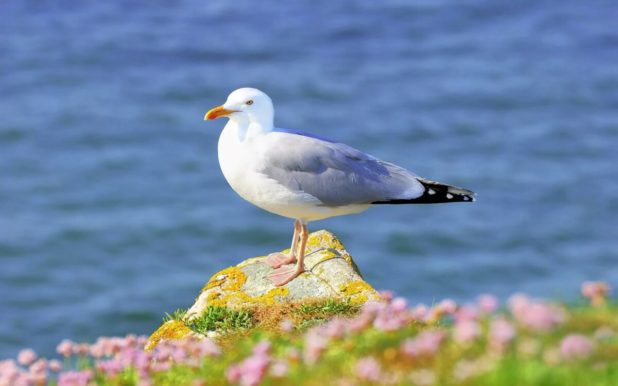It would be hard to imagine lakes or seas without seagulls. These birds live wherever they can catch other aquatic inhabitants or collect garbage. The seagull is an aggressive and quarrelsome representative of birds. Such a bird is used to living in a large group and is constantly fighting for a better place or food supply.
Ornithologists were able to identify 44 varieties of gulls. The largest such bird has a wingspan of 1.5 meters, and the smallest – 0.5 meters.
1. The body weight of seagulls is not very large: on average, it ranges from 240 to 400 grams. The body of such a feathered bird is slender.
2. The common gull makes flights in small flocks, and their flight is carried out in the form of a triangle.
3. Sea gulls are great swimmers, and are even able to sleep on the water.
4. Due to the presence of a special gland on the seagull, such a bird is able to drink salt water. This gland is located above the eyes of the bird, and it cleans the seagull’s blood from salt, which the gland removes through the nostrils.
5. Seagulls are able to attack people in flocks, protecting their own space. In the United States of America, there are even instructions for postmen on what to do during an attack by these birds.
6. In certain areas, 70% of the diet of seagulls is fish waste.
7. The black-headed gull can break eggs in its own and neighboring clutches if it notices a person when they are laid or in the first days of incubation.
8. In Salt Lake City, there is a 50-meter granite column, with 2 bronze birds on the globe. Thus, they tried to perpetuate the memory of the California gull, which symbolized the state of Utah and saved the farmers’ crops from locusts in the middle of the 19th century.
9. In 2011, the Paris Mint featured Audouin’s Seagull – rather rare bird living on some Mediterranean islands.
10. Sea gulls have swimming membranes, due to which a bird of this type moves perfectly in the water, but such birds were not attributed to the oceanic species.
11. Recently, seagulls have been considered “scavengers” and serious competitors to crows that live in the territory of consumer and industrial waste.
12. The smallest member of the – This is a small gull, its average weight is 100-150 grams. The largest gull is the sea gull. The weight of such an adult often exceeds 2 kilograms.
13. Seagulls have no social relations with relatives. They not only sometimes eat other species of gulls, but also occasionally engage in cannibalism.
14. When a seagull is hunting for fish, it can dive head first into the water.
15. Of all the varieties of gulls, the California gull has become the smartest. Unlike other subspecies, this gull nests on the mainland, in areas remote from the ocean. The lifestyle of such a feathered gull led Mormons to worship the California gull like the divine incarnation of Elohim.
16. At the moment of flight, the sea gull reaches a speed of 110 km/h.
17. Gull colonies often become mixed. They willingly nest nearby with herons, cormorants, wild ducks and other bird species.
18. Seagulls are intelligent and curious birds that are capable of playing games, stealing prey from other birds, as well as stalking other animals and even taking advantage of humans.
19. Until the age of 4, the sea gull has gray feathers, after which it begins to turn white.
20. For a comfortable life, a seagull needs a large amount of food – at least 400 grams per day for an adult.
21. Nothing bad will happen if one clutch of seagulls dies. In such a situation, the female immediately lays a few more eggs. This process can be repeated up to 4 times in gulls.
22. Sailors could learn to determine the proximity of a storm by the behavior of these birds. If a seagull sits on a mast or on the water, then you can not be afraid of storms.
23. In Hitchcock’s film The Birds, American herring gulls were portrayed as winged stubborn pursuers of man. But, as it turned out, this plot was not invented. Violent attacks by European herring gulls caused by humans entering bird territory have resulted in serious head injuries that have resulted in death in several cases.
24. The seagull has a useful adaptation. The wings of this bird have a higher ratio of width and length compared to the shorter wings of other birds, which allows the gull to make easy maneuvers.
25. Adult gulls have distinctive spots on their bills that have become visual cues for their chicks. In order to convince adults to regurgitate their food, the chicks have to peck at these marks.
26. Seagulls have the ability to build nests almost anywhere and from any material. They can build a nest from grass, feathers, twigs, bits of nets, cans and other debris.
27. Many gulls winter in the Black or Caspian Seas, and some fly to the North or Mediterranean Sea. They can also migrate to African states, Japan, and China.
28. In many cultures, the seagull was considered a symbol of versatility, freedom and a carefree way of life. In Celtic and Irish mythology, Manannan Mac Lir was a trickster and god of the sea, and was often depicted as a seagull.
29. Seagulls face many of the threats common to seabirds, such as oil pollution, line entanglement and plastic intrusion. One-legged gulls are not uncommon, and although these birds adapt easily to this kind of injury, conscientious gull lovers take steps to protect such unique and charming birds.
30. If, while hatching or feeding chicks, a seagull notices danger, then the commotion will cover the entire colony of birds. Seagulls will then fly into the air, begin to twist over the disturber of the peace and shrillly scream.
